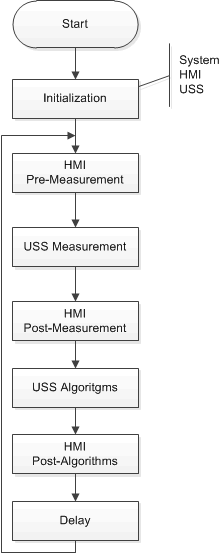JAJU680A January 2019 – July 2022
- 概要
- Resources
- 特長
- アプリケーション
- 5
- 1System Description
- 2System Overview
- 3Hardware, Software, Testing Requirements, and Test Results
- 4Design and Documentation Support
- 5About the Authors
- 6Revision History
3.1.2.3 Application
Figure 4-4 shows the flow diagram of the application.
 Figure 4-4 Application Flow Diagram
Figure 4-4 Application Flow DiagramThe application starts by initializing the basic functionality of the system including peripherals, clocks, and I/Os, followed by initializing the HMI peripherals including LCD, GUI communication, buttons, and LEDs. Finally, the system performs the initial configuration of the ultrasonic subsystem and its algorithms.
After initialization, the application stays in a continuous loop performing the following tasks:
- HMI pre-measurement: Performs user interaction functions before an ultrasonic measurement, such as checking if the GUI has a new configuration to send or if the user pressed a button.
- USS measurement: Performs an ultrasonic measurement. The result of this function is an ADC-sampled waveform.
- HMI post-measurement: Performs user interaction functions after a measurement such as sending the ADC waveform to the GUI.
- USS algorithms: Runs ultrasonic algorithms on the ADC-sampled waveform to calculate data such as the ToF and volume flow rate.
- HMI post-algorithms: Performs user interaction functions after the algorithms are executed. This includes sending the results to the GUI or displaying them on the LCD.
- Delay: The device goes to a low-power state waiting for the next iteration.
For more information on the architecture and implementation of the application, see the MSP Ultrasonic Sensing User’s Guide and the USS Library API Guide.